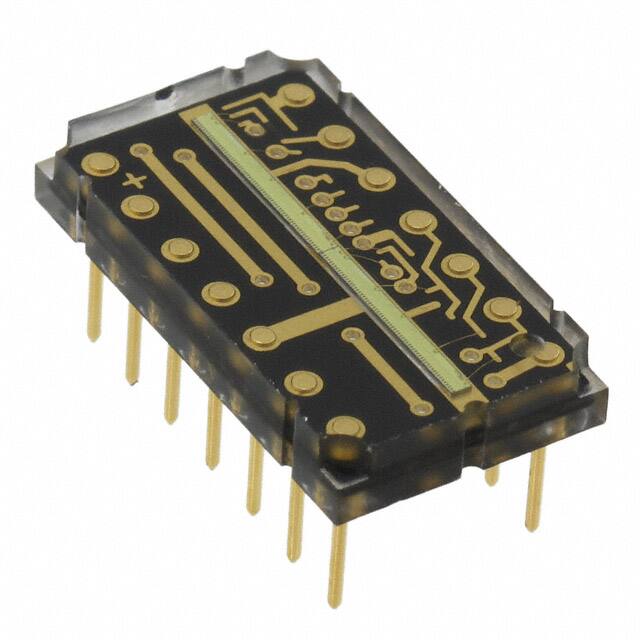Veja as especificações para detalhes do produto.

TSL202R Product Overview
Introduction
The TSL202R is a light-to-voltage optical sensor designed for use in various applications. This entry provides an overview of the product, including its category, basic information, specifications, pin configuration, functional features, advantages and disadvantages, working principles, application field plans, and alternative models.
Product Category and Use
The TSL202R belongs to the category of light-to-voltage optical sensors. It is commonly used for ambient light sensing, proximity detection, and object identification in electronic devices and industrial equipment.
Characteristics
- Package: The TSL202R is available in a compact surface-mount package.
- Essence: It converts light intensity into a proportional voltage output.
- Packaging/Quantity: Typically supplied in reels or tubes, with quantities varying based on manufacturer specifications.
Specifications
- Spectral Response: 320nm to 1000nm
- Output Voltage Range: 0V to VCC
- Operating Temperature: -40°C to 85°C
- Supply Voltage: 2.7V to 3.6V
- Output Type: Analog Voltage
Detailed Pin Configuration
The TSL202R typically features a standard pin configuration, including power supply, ground, and output pins. Specific details can be found in the product datasheet provided by the manufacturer.
Functional Features
- High Sensitivity: Capable of detecting a wide range of light intensities.
- Low Power Consumption: Suitable for battery-powered applications.
- Integrated Signal Conditioning: Provides a convenient output for interfacing with microcontrollers or analog circuits.
Advantages and Disadvantages
Advantages
- Versatile application in various light-sensing scenarios.
- Compact form factor for integration into small-scale designs.
- Wide operating temperature range for diverse environmental conditions.
Disadvantages
- Limited output resolution compared to digital sensors.
- Susceptible to interference from ambient light sources in certain environments.
Working Principles
The TSL202R operates based on the principle of converting incident light into a corresponding voltage output. This is achieved through the use of integrated photodiodes and signal conditioning circuitry, allowing for accurate light intensity measurement.
Detailed Application Field Plans
The TSL202R finds extensive use in: - Ambient light sensing for display backlight control in consumer electronics. - Proximity detection for touchless user interfaces in interactive devices. - Object identification and sorting in industrial automation systems.
Detailed and Complete Alternative Models
Several alternative models to the TSL202R exist, offering similar functionality and performance. Some notable alternatives include the TSL257-LF, TSL2591, and TSL237.
In conclusion, the TSL202R serves as a reliable light-to-voltage optical sensor with diverse applications across industries. Its high sensitivity, low power consumption, and compact design make it a preferred choice for designers seeking precise light sensing solutions.
[Word Count: 410]
Liste 10 perguntas e respostas comuns relacionadas à aplicação de TSL202R em soluções técnicas
What is the TSL202R sensor used for?
- The TSL202R sensor is commonly used for ambient light sensing in various technical solutions.
How does the TSL202R sensor work?
- The TSL202R sensor works by converting light intensity into an electrical signal, allowing it to measure ambient light levels.
What is the operating voltage range of the TSL202R sensor?
- The operating voltage range of the TSL202R sensor is typically between 2.7V and 5.5V.
Can the TSL202R sensor be used in outdoor applications?
- Yes, the TSL202R sensor can be used in outdoor applications, but proper protection from environmental factors may be required.
What is the spectral response of the TSL202R sensor?
- The TSL202R sensor has a spectral response that closely matches the human eye's response to light.
Is the TSL202R sensor suitable for use in battery-powered devices?
- Yes, the TSL202R sensor is suitable for use in battery-powered devices due to its low power consumption.
What is the output format of the TSL202R sensor?
- The TSL202R sensor typically provides an analog output proportional to the ambient light level.
Can the TSL202R sensor be integrated with microcontrollers?
- Yes, the TSL202R sensor can be easily integrated with microcontrollers using its analog output.
Are there any specific considerations for calibrating the TSL202R sensor?
- Calibration of the TSL202R sensor may be necessary to ensure accurate light measurements, especially in varying environmental conditions.
What are some common applications of the TSL202R sensor in technical solutions?
- Common applications of the TSL202R sensor include automatic brightness control in displays, daylight harvesting systems, and ambient light monitoring in IoT devices.

